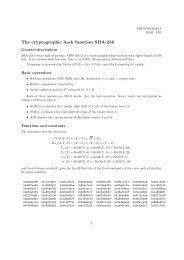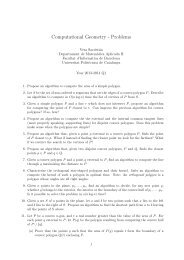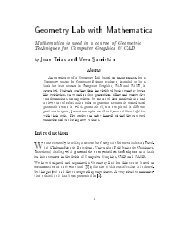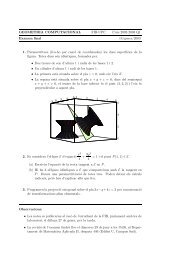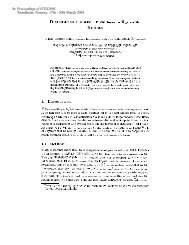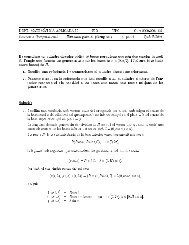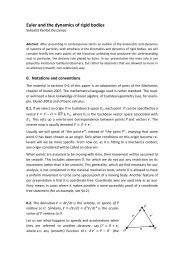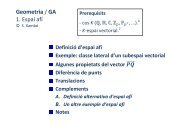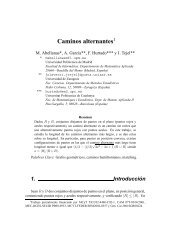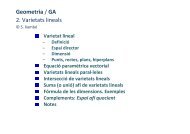STORING THE VORONOI DIAGRAM - UPC
STORING THE VORONOI DIAGRAM - UPC
STORING THE VORONOI DIAGRAM - UPC
Create successful ePaper yourself
Turn your PDF publications into a flip-book with our unique Google optimized e-Paper software.
<strong>STORING</strong> <strong>THE</strong><br />
<strong>VORONOI</strong> <strong>DIAGRAM</strong><br />
Vera Sacristán<br />
Computational Geometry<br />
Facultat d’Informàtica de Barcelona<br />
Universitat Politècnica de Catalunya
Storing the Voronoi diagram<br />
Computational Geometry, Facultat d’Informàtica de Barcelona, <strong>UPC</strong><br />
Possible options, advantages and disadvantages
Storing the Voronoi diagram<br />
Computational Geometry, Facultat d’Informàtica de Barcelona, <strong>UPC</strong><br />
Possible options, advantages and disadvantages<br />
Storing the list of all the edges of the diagram
Storing the Voronoi diagram<br />
Computational Geometry, Facultat d’Informàtica de Barcelona, <strong>UPC</strong><br />
Possible options, advantages and disadvantages<br />
Storing the list of all the edges of the diagram<br />
Advantage: small memory usage.<br />
Disadvantage: it suffices to draw the diagram, but it does not contain the proximity<br />
information. For example, given a site p i , finding its neighbors or reporting the vertices and<br />
edges of its Voronoi region is too expensive.
Storing the Voronoi diagram<br />
Computational Geometry, Facultat d’Informàtica de Barcelona, <strong>UPC</strong><br />
Possible options, advantages and disadvantages<br />
Storing the list of all the edges of the diagram<br />
Advantage: small memory usage.<br />
Disadvantage: it suffices to draw the diagram, but it does not contain the proximity<br />
information. For example, given a site p i , finding its neighbors or reporting the vertices and<br />
edges of its Voronoi region is too expensive.<br />
For each site p i , storing the sorted list of vertices and edges of its Voronoi region, as well as<br />
the sorted list of its neighbors, etc.
Storing the Voronoi diagram<br />
Computational Geometry, Facultat d’Informàtica de Barcelona, <strong>UPC</strong><br />
Possible options, advantages and disadvantages<br />
Storing the list of all the edges of the diagram<br />
Advantage: small memory usage.<br />
Disadvantage: it suffices to draw the diagram, but it does not contain the proximity<br />
information. For example, given a site p i , finding its neighbors or reporting the vertices and<br />
edges of its Voronoi region is too expensive.<br />
For each site p i , storing the sorted list of vertices and edges of its Voronoi region, as well as<br />
the sorted list of its neighbors, etc.<br />
Advantage: allows to quickly recover neighborhood information.<br />
Disadvantage: the stored data is redundant and it uses more space than required.
Storing the Voronoi diagram<br />
Computational Geometry, Facultat d’Informàtica de Barcelona, <strong>UPC</strong><br />
Possible options, advantages and disadvantages<br />
Storing the list of all the edges of the diagram<br />
Advantage: small memory usage.<br />
Disadvantage: it suffices to draw the diagram, but it does not contain the proximity<br />
information. For example, given a site p i , finding its neighbors or reporting the vertices and<br />
edges of its Voronoi region is too expensive.<br />
For each site p i , storing the sorted list of vertices and edges of its Voronoi region, as well as<br />
the sorted list of its neighbors, etc.<br />
Advantage: allows to quickly recover neighborhood information.<br />
Disadvantage: the stored data is redundant and it uses more space than required.<br />
The data structure which is most frequently used to store Voronoi diagrams is the DCEL (doubly<br />
connected edge list).<br />
The DCEL is also used to store plane partitions, polyhedra, meshes, etc.
Storing the Voronoi diagram<br />
Computational Geometry, Facultat d’Informàtica de Barcelona, <strong>UPC</strong><br />
DCEL
Storing the Voronoi diagram<br />
Computational Geometry, Facultat d’Informàtica de Barcelona, <strong>UPC</strong><br />
DCEL<br />
4<br />
3<br />
2<br />
1
Storing the Voronoi diagram<br />
Computational Geometry, Facultat d’Informàtica de Barcelona, <strong>UPC</strong><br />
DCEL<br />
3<br />
4<br />
2<br />
4<br />
3<br />
2<br />
3 1<br />
6<br />
1 5<br />
2<br />
4<br />
1<br />
5
Storing the Voronoi diagram<br />
Computational Geometry, Facultat d’Informàtica de Barcelona, <strong>UPC</strong><br />
DCEL<br />
7<br />
4<br />
8<br />
3<br />
6<br />
2<br />
4<br />
3<br />
2<br />
3 1<br />
6<br />
1 5<br />
2<br />
4<br />
1<br />
9<br />
5<br />
∞
Storing the Voronoi diagram<br />
Computational Geometry, Facultat d’Informàtica de Barcelona, <strong>UPC</strong><br />
DCEL<br />
e<br />
7<br />
4<br />
8<br />
3<br />
6<br />
2<br />
4<br />
3<br />
2<br />
3 1<br />
6<br />
1 5<br />
2<br />
4<br />
1<br />
9<br />
5<br />
∞
Storing the Voronoi diagram<br />
Computational Geometry, Facultat d’Informàtica de Barcelona, <strong>UPC</strong><br />
DCEL<br />
v B<br />
e<br />
v E<br />
7<br />
4<br />
8<br />
3<br />
6<br />
2<br />
4<br />
3<br />
2<br />
3 1<br />
6<br />
1 5<br />
2<br />
4<br />
1<br />
9<br />
5<br />
∞
Storing the Voronoi diagram<br />
Computational Geometry, Facultat d’Informàtica de Barcelona, <strong>UPC</strong><br />
DCEL<br />
v E<br />
f L<br />
f R<br />
v B<br />
e<br />
7<br />
4<br />
8<br />
3<br />
6<br />
2<br />
4<br />
3<br />
2<br />
3 1<br />
6<br />
1 5<br />
2<br />
4<br />
1<br />
9<br />
5<br />
∞
Storing the Voronoi diagram<br />
Computational Geometry, Facultat d’Informàtica de Barcelona, <strong>UPC</strong><br />
DCEL<br />
v E<br />
e N<br />
f L<br />
f R<br />
v B<br />
e<br />
7<br />
4<br />
8<br />
3<br />
6<br />
2<br />
4<br />
3<br />
2<br />
3 1<br />
6<br />
1 5<br />
2<br />
4<br />
1<br />
9<br />
5<br />
∞
Storing the Voronoi diagram<br />
Computational Geometry, Facultat d’Informàtica de Barcelona, <strong>UPC</strong><br />
DCEL<br />
e P<br />
e<br />
v E<br />
f L<br />
f R<br />
e N<br />
v B<br />
7<br />
4<br />
8<br />
3<br />
6<br />
2<br />
4<br />
3<br />
2<br />
3 1<br />
6<br />
1 5<br />
2<br />
4<br />
1<br />
9<br />
5<br />
∞
Storing the Voronoi diagram<br />
Computational Geometry, Facultat d’Informàtica de Barcelona, <strong>UPC</strong><br />
Table of faces<br />
DCEL<br />
p x y e<br />
1 x 1 y 1 4<br />
2 x 2 y 2 4<br />
3 x 3 y 3 1<br />
4 x 4 y 4 3<br />
∞ — — 9<br />
7<br />
4<br />
8<br />
3<br />
6<br />
2<br />
4<br />
3<br />
2<br />
3 1<br />
6<br />
1 5<br />
2<br />
4<br />
1<br />
9<br />
5<br />
∞
Storing the Voronoi diagram<br />
Computational Geometry, Facultat d’Informàtica de Barcelona, <strong>UPC</strong><br />
Table of faces<br />
Table of vertices<br />
DCEL<br />
p x y e<br />
1 x 1 y 1 4<br />
2 x 2 y 2 4<br />
3 x 3 y 3 1<br />
4 x 4 y 4 3<br />
∞ — — 9<br />
v x y e original<br />
1 x 1 y 1 1 1<br />
2 x 2 y 2 1 1<br />
3 x 3 y 3 2 0<br />
4 x 4 y 4 8 0<br />
5 x 5 y 5 4 0<br />
6 x 6 y 6 9 0<br />
7<br />
4<br />
8<br />
3<br />
6<br />
2<br />
4<br />
3<br />
2<br />
3 1<br />
6<br />
1 5<br />
2<br />
4<br />
1<br />
9<br />
5<br />
∞
Storing the Voronoi diagram<br />
Computational Geometry, Facultat d’Informàtica de Barcelona, <strong>UPC</strong><br />
Table of faces<br />
Table of vertices<br />
DCEL<br />
p x y e<br />
1 x 1 y 1 4<br />
2 x 2 y 2 4<br />
3 x 3 y 3 1<br />
4 x 4 y 4 3<br />
∞ — — 9<br />
DCEL<br />
v x y e original<br />
1 x 1 y 1 1 1<br />
2 x 2 y 2 1 1<br />
3 x 3 y 3 2 0<br />
4 x 4 y 4 8 0<br />
5 x 5 y 5 4 0<br />
6 x 6 y 6 9 0<br />
e v B v E f L f R e P e N<br />
1 1 2 2 3 4 2<br />
2 2 3 4 3 3 6<br />
3 2 4 2 4 1 7<br />
4 1 5 1 2 5 8<br />
5 1 6 3 1 1 9<br />
6 6 3 3 ∞ 5 7<br />
7 3 4 4 ∞ 2 8<br />
8 5 4 ∞ 2 9 3<br />
9 5 6 1 ∞ 4 6<br />
7<br />
4<br />
8<br />
3<br />
6<br />
2<br />
4<br />
3<br />
2<br />
3 1<br />
6<br />
1 5<br />
2<br />
4<br />
1<br />
9<br />
5<br />
∞
Storing the Voronoi diagram<br />
Table of faces<br />
Table of vertices<br />
DCEL<br />
p x y e<br />
1 x 1 y 1 4<br />
2 x 2 y 2 4<br />
3 x 3 y 3 1<br />
4 x 4 y 4 3<br />
∞ — — 9<br />
DCEL<br />
v x y e original<br />
1 x 1 y 1 1 1<br />
2 x 2 y 2 1 1<br />
3 x 3 y 3 2 0<br />
4 x 4 y 4 8 0<br />
5 x 5 y 5 4 0<br />
6 x 6 y 6 9 0<br />
e v B v E f L f R e P e N<br />
1 1 2 2 3 4 2<br />
2 2 3 4 3 3 6<br />
3 2 4 2 4 1 7<br />
4 1 5 1 2 5 8<br />
5 1 6 3 1 1 9<br />
6 6 3 3 ∞ 5 7<br />
7 3 4 4 ∞ 2 8<br />
8 5 4 ∞ 2 9 3<br />
9 5 6 1 ∞ 4 6<br />
Computational Geometry, Facultat d’Informàtica de Barcelona, <strong>UPC</strong><br />
• For each face:<br />
Storage space<br />
2 coordinates + 1 pointer.<br />
• For each vertex:<br />
2 coordinates + 1 pointer + 1 bit.<br />
• For each edge:<br />
6 pointers.<br />
In total, the storage space is O(n).
Storing the Voronoi diagram<br />
Computational Geometry, Facultat d’Informàtica de Barcelona, <strong>UPC</strong><br />
There are other DCEL variants, as for example:<br />
DCEL
Storing the Voronoi diagram<br />
Computational Geometry, Facultat d’Informàtica de Barcelona, <strong>UPC</strong><br />
There are other DCEL variants, as for example:<br />
DCEL<br />
e ′<br />
e
Storing the Voronoi diagram<br />
Computational Geometry, Facultat d’Informàtica de Barcelona, <strong>UPC</strong><br />
There are other DCEL variants, as for example:<br />
e −→ v B , f R , e N , e ′<br />
e ′ −→ v B , f R , e N , e<br />
DCEL<br />
e ′<br />
e
Storing the Voronoi diagram<br />
Computational Geometry, Facultat d’Informàtica de Barcelona, <strong>UPC</strong><br />
There are other DCEL variants, as for example:<br />
e −→ v B , f R , e N , e ′<br />
e ′ −→ v B , f R , e N , e<br />
DCEL<br />
e N (e)<br />
e ′<br />
v B (e)<br />
e<br />
f R (e)
Storing the Voronoi diagram<br />
Computational Geometry, Facultat d’Informàtica de Barcelona, <strong>UPC</strong><br />
There are other DCEL variants, as for example:<br />
e −→ v B , f R , e N , e ′<br />
e ′ −→ v B , f R , e N , e<br />
DCEL<br />
f R (e ′ )<br />
e ′<br />
e<br />
v B (e ′ )<br />
f R (e)<br />
e N (e)<br />
e N (e ′ )<br />
v B (e)
Storing the Voronoi diagram<br />
Computational Geometry, Facultat d’Informàtica de Barcelona, <strong>UPC</strong><br />
There are other DCEL variants, as for example:<br />
DCEL<br />
e −→ v B , f R , e N , e ′<br />
e ′ −→ v B , f R , e N , e<br />
e N (e ′ )<br />
f R (e ′ )<br />
e ′<br />
v B (e)<br />
e<br />
v B (e ′ )<br />
f R (e)<br />
e N (e)<br />
7<br />
4<br />
8<br />
3<br />
6<br />
2<br />
4<br />
3<br />
2<br />
3 1<br />
6<br />
1 5<br />
2<br />
4<br />
1<br />
9<br />
5<br />
∞
Storing the Voronoi diagram<br />
Computational Geometry, Facultat d’Informàtica de Barcelona, <strong>UPC</strong><br />
DCEL<br />
e v B v E f L f R e P e N<br />
1 1 2 2 3 4 2<br />
2 2 3 4 3 3 6<br />
3 2 4 2 4 1 7<br />
4 1 5 1 2 5 8<br />
5 1 6 3 1 1 9<br />
6 6 3 3 ∞ 5 7<br />
7 3 4 4 ∞ 2 8<br />
8 5 4 ∞ 2 9 3<br />
9 5 6 1 ∞ 4 6<br />
7<br />
4<br />
8<br />
3<br />
6<br />
2<br />
4<br />
3<br />
2<br />
3 1<br />
6<br />
1 5<br />
2<br />
4<br />
1<br />
9<br />
5<br />
∞
Storing the Voronoi diagram<br />
Computational Geometry, Facultat d’Informàtica de Barcelona, <strong>UPC</strong><br />
e v B f R e N e ′<br />
1 1 3 2 1’<br />
2 2 3 6 2’<br />
3 2 4 7 3’<br />
4 1 2 8 4’<br />
5 1 1 9 5’<br />
6 6 ∞ 7 6’<br />
7 3 ∞ 8 7’<br />
8 5 2 3 8’<br />
9 5 ∞ 6 9’<br />
1’ 2 2 4 1<br />
2’ 3 4 3 2<br />
3’ 4 2 1 3<br />
4’ 5 1 5 4<br />
5’ 6 3 1 5<br />
6’ 3 3 5 6<br />
7’ 4 4 2 7<br />
8’ 4 ∞ 9 8<br />
9’ 6 1 4 9<br />
DCEL<br />
7<br />
4<br />
8<br />
3<br />
6<br />
2<br />
4<br />
3<br />
2<br />
3 1<br />
6<br />
1 5<br />
2<br />
4<br />
1<br />
9<br />
5<br />
∞
Voronoi diagram storage<br />
Computational Geometry, Facultat d’Informàtica de Barcelona, <strong>UPC</strong><br />
How to obtain information from the DCEL
Voronoi diagram storage<br />
Computational Geometry, Facultat d’Informàtica de Barcelona, <strong>UPC</strong><br />
How to obtain information from the DCEL<br />
Sorted list of the edges and faces incident to a given Voronoi vertex
Voronoi diagram storage<br />
Computational Geometry, Facultat d’Informàtica de Barcelona, <strong>UPC</strong><br />
How to obtain information from the DCEL<br />
Sorted list of the edges and faces incident to a given Voronoi vertex<br />
Input: v i , a Voronoi vertex<br />
Output: listE and listF , sorted in counterclockwise order
Voronoi diagram storage<br />
Computational Geometry, Facultat d’Informàtica de Barcelona, <strong>UPC</strong><br />
How to obtain information from the DCEL<br />
Sorted list of the edges and faces incident to a given Voronoi vertex<br />
Input: v i , a Voronoi vertex<br />
Output: listE and listF , sorted in counterclockwise order<br />
Procedure:<br />
Initialization<br />
listE = { }, listF = { }, e = e(v i )<br />
Advance<br />
Add e to listE<br />
If i = v B (e), then<br />
else<br />
add f L (e) to listF<br />
e = e P (e)<br />
add f R (e) to listF<br />
e = e N (e)<br />
Repeat until e coincides again with e(v i )<br />
e P<br />
v B<br />
e<br />
v E<br />
f L<br />
f R<br />
e N
Voronoi diagram storage<br />
Computational Geometry, Facultat d’Informàtica de Barcelona, <strong>UPC</strong><br />
How to obtain information from the DCEL<br />
Sorted list of the edges and faces incident to a given Voronoi vertex<br />
Input: v i , a Voronoi vertex<br />
Output: listE and listF , sorted in counterclockwise order<br />
Procedure:<br />
Initialization<br />
listE = { }, listF = { }, e = e(v i )<br />
Advance<br />
Add e to listE<br />
If i = v B (e), then<br />
else<br />
add f L (e) to listF<br />
e = e P (e)<br />
add f R (e) to listF<br />
e = e N (e)<br />
Repeat until e coincides again with e(v i )<br />
e P<br />
v B<br />
e<br />
v E<br />
f L<br />
f R<br />
e N<br />
The running time of this algorithm<br />
is linear in the number<br />
of edges (faces) incident to v i
Voronoi diagram storage<br />
Computational Geometry, Facultat d’Informàtica de Barcelona, <strong>UPC</strong><br />
How to obtain information from the DCEL<br />
Sorted list of vertices and edges of a Voronoi region
Voronoi diagram storage<br />
Computational Geometry, Facultat d’Informàtica de Barcelona, <strong>UPC</strong><br />
How to obtain information from the DCEL<br />
Sorted list of vertices and edges of a Voronoi region<br />
Input: p i , a site<br />
Output: listE and listV , sorted in clockwise order
Voronoi diagram storage<br />
Computational Geometry, Facultat d’Informàtica de Barcelona, <strong>UPC</strong><br />
How to obtain information from the DCEL<br />
Sorted list of vertices and edges of a Voronoi region<br />
Input: p i , a site<br />
Output: listE and listV , sorted in clockwise order<br />
Procedure:<br />
Initialization<br />
listE = { }, listV = { }, e = e(p i )<br />
Advance<br />
Add e to listE<br />
If i = f L (e), then<br />
else<br />
add v B (e) to listV<br />
e = e P (e)<br />
addr v E (e) to listV<br />
e = e N (e)<br />
Repeat until e coincides again with e(v i )<br />
e P<br />
v B<br />
e<br />
v E<br />
f L<br />
f R<br />
e N
Voronoi diagram storage<br />
Computational Geometry, Facultat d’Informàtica de Barcelona, <strong>UPC</strong><br />
How to obtain information from the DCEL<br />
Sorted list of vertices and edges of a Voronoi region<br />
Input: p i , a site<br />
Output: listE and listV , sorted in clockwise order<br />
Procedure:<br />
Initialization<br />
listE = { }, listV = { }, e = e(p i )<br />
Advance<br />
Add e to listE<br />
If i = f L (e), then<br />
else<br />
add v B (e) to listV<br />
e = e P (e)<br />
addr v E (e) to listV<br />
e = e N (e)<br />
Repeat until e coincides again with e(v i )<br />
e P<br />
v B<br />
e<br />
v E<br />
f L<br />
f R<br />
e N<br />
The running time of this algorithm<br />
is linear to the number<br />
of edges (vertices) of the<br />
Voronoi region of p i
Voronoi diagram storage<br />
Computational Geometry, Facultat d’Informàtica de Barcelona, <strong>UPC</strong><br />
How to obtain information from the DCEL<br />
Convex hull of P<br />
7<br />
4<br />
3<br />
2<br />
3<br />
6<br />
4<br />
8<br />
2<br />
3 1<br />
6<br />
1 5<br />
2<br />
4 1<br />
9<br />
5<br />
∞
Voronoi diagram storage<br />
Computational Geometry, Facultat d’Informàtica de Barcelona, <strong>UPC</strong><br />
How to obtain information from the DCEL<br />
Convex hull of P<br />
When p i = ∞, the previous algorithm returns, in counterclockwise order, the (fictitious) edges<br />
of the Voronoi region of this (fictitious) point. For each obtained edge, reporting its other<br />
adjacent Voronoi face will produce the sorted list of the convex hull vertices of P , in time<br />
proportional to its size.<br />
7<br />
4<br />
3<br />
2<br />
3<br />
6<br />
4<br />
8<br />
2<br />
3 1<br />
6<br />
1 5<br />
2<br />
4 1<br />
9<br />
5<br />
∞
Voronoi diagram storage<br />
Computational Geometry, Facultat d’Informàtica de Barcelona, <strong>UPC</strong><br />
How to obtain information from the DCEL<br />
Delaunay diagram<br />
7<br />
4<br />
3<br />
2<br />
3<br />
6<br />
4<br />
8<br />
2<br />
3 1<br />
6<br />
1 5<br />
2<br />
4 1<br />
9<br />
5<br />
∞
Voronoi diagram storage<br />
Computational Geometry, Facultat d’Informàtica de Barcelona, <strong>UPC</strong><br />
How to obtain information from the DCEL<br />
Delaunay diagram<br />
The DCEL storing the Voronoi diagram information and the DCEL storing the Delaunay triangulation<br />
information are the same, we just need to do some “dual reading”:<br />
7<br />
4<br />
3<br />
2<br />
3<br />
6<br />
4<br />
8<br />
2<br />
3 1<br />
6<br />
1 5<br />
2<br />
4 1<br />
9<br />
5<br />
∞
Voronoi diagram storage<br />
Computational Geometry, Facultat d’Informàtica de Barcelona, <strong>UPC</strong><br />
How to obtain information from the DCEL<br />
Delaunay diagram<br />
The DCEL storing the Voronoi diagram information and the DCEL storing the Delaunay triangulation<br />
information are the same, we just need to do some “dual reading”:<br />
Voronoi:<br />
Delaunay:<br />
7<br />
4<br />
3<br />
2<br />
3<br />
6<br />
4<br />
8<br />
2<br />
3 1<br />
6<br />
1 5<br />
2<br />
4 1<br />
9<br />
5<br />
∞
Voronoi diagram storage<br />
Computational Geometry, Facultat d’Informàtica de Barcelona, <strong>UPC</strong><br />
How to obtain information from the DCEL<br />
Delaunay diagram<br />
The DCEL storing the Voronoi diagram information and the DCEL storing the Delaunay triangulation<br />
information are the same, we just need to do some “dual reading”:<br />
Voronoi:<br />
Delaunay:<br />
faces<br />
vertices<br />
p x y e<br />
p x y e<br />
incident<br />
7<br />
4<br />
3<br />
2<br />
3<br />
6<br />
4<br />
8<br />
2<br />
3 1<br />
6<br />
1 5<br />
2<br />
4 1<br />
9<br />
5<br />
∞
Voronoi diagram storage<br />
Computational Geometry, Facultat d’Informàtica de Barcelona, <strong>UPC</strong><br />
How to obtain information from the DCEL<br />
Delaunay diagram<br />
The DCEL storing the Voronoi diagram information and the DCEL storing the Delaunay triangulation<br />
information are the same, we just need to do some “dual reading”:<br />
Voronoi:<br />
Delaunay:<br />
vertices<br />
triangles<br />
v x y e original<br />
v x y e original<br />
circumcenter edge<br />
7<br />
4<br />
3<br />
2<br />
3<br />
6<br />
4<br />
8<br />
2<br />
3 1<br />
6<br />
1 5<br />
2<br />
4 1<br />
9<br />
5<br />
∞
Voronoi diagram storage<br />
Computational Geometry, Facultat d’Informàtica de Barcelona, <strong>UPC</strong><br />
How to obtain information from the DCEL<br />
Delaunay diagram<br />
The DCEL storing the Voronoi diagram information and the DCEL storing the Delaunay triangulation<br />
information are the same, we just need to do some “dual reading”:<br />
Voronoi:<br />
Delaunay:<br />
edges<br />
edges<br />
e v B v E f L f R e P e N<br />
e f L f R v E v B e N e P<br />
dual<br />
clockwise<br />
7<br />
4<br />
3<br />
2<br />
3<br />
6<br />
4<br />
8<br />
2<br />
3 1<br />
6<br />
1 5<br />
2<br />
4 1<br />
9<br />
5<br />
∞



